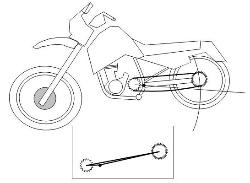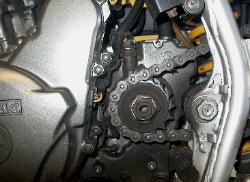




Top Gun Chain Master
Copyright © 2006 Top Gun Motorcycles. All rights reserved. Distribution or publication of this document (electronic or otherwise)
is prohibited without the express written consent of the author. For more information or to request permission to publish this
document, please see our contact page. For information on our pledge to maintain your privacy click here. To learn more about
your friends at Top Gun Motorcycles, read about us here.
is prohibited without the express written consent of the author. For more information or to request permission to publish this
document, please see our contact page. For information on our pledge to maintain your privacy click here. To learn more about
your friends at Top Gun Motorcycles, read about us here.
| Top Gun Motorcycles |
| KLR-650 Chain Master (Patent Pending) Upper Chain Run Control Device *Engineered using a stock KLR-650 with properly adjusted chain.* |


| The Chain Master at work. |
| Even at stock close with proper adjustment, the chain can strike the airbox vent-tube cover. |
The following pictures were taken using a KLR with a properly adjusted chain. If your
chain is loose, or if you have installed lowering links without properly adjusting your
chain slack measurements to account for your new swingarm position, you will have
more chain slack than depicted.
The two pictures below are taken with the swingarm at stock-shock close. That is to
say, with stock shock and links, your swingarm should not rise any higher than this. The
picture on the left shows the Chain Master engaging the chain (note: actual product
has a black chain roller; the white roller was for testing purposes only but is the same
size). The picture on the right shows the same swingarm position without a chain roller,
and with maximum upward deflection, as occurs with a low throttle position while the
suspension is fully compressed. Notice that the chain is more than capable of hitting the
airbox vent-tube cover.
chain is loose, or if you have installed lowering links without properly adjusting your
chain slack measurements to account for your new swingarm position, you will have
more chain slack than depicted.
The two pictures below are taken with the swingarm at stock-shock close. That is to
say, with stock shock and links, your swingarm should not rise any higher than this. The
picture on the left shows the Chain Master engaging the chain (note: actual product
has a black chain roller; the white roller was for testing purposes only but is the same
size). The picture on the right shows the same swingarm position without a chain roller,
and with maximum upward deflection, as occurs with a low throttle position while the
suspension is fully compressed. Notice that the chain is more than capable of hitting the
airbox vent-tube cover.
We designed the Chain Master using a
stock KLR-650 with stock rear suspension
and a properly adjusted chain. We still
wanted to see what would happen at
maximum swingarm travel. In this case,
the muffler on the right side of the bike is
actually contacting the swingarm. We
would like to think getting to this point
would be impossible. Unfortunately, we
have seen KLR-650's with modified
suspensions - particularly, improperly
installed lowering links - where the muffler
was indeed impacting the swingarm.
Notice in the next two figures that the
Chain Master is still able to control the
upper chain run. The lower picture shows
that even with a static chain, something
you won't see on your own bike under
riding conditions, the chain easily makes
contact with the vent-tube and cover.
stock KLR-650 with stock rear suspension
and a properly adjusted chain. We still
wanted to see what would happen at
maximum swingarm travel. In this case,
the muffler on the right side of the bike is
actually contacting the swingarm. We
would like to think getting to this point
would be impossible. Unfortunately, we
have seen KLR-650's with modified
suspensions - particularly, improperly
installed lowering links - where the muffler
was indeed impacting the swingarm.
Notice in the next two figures that the
Chain Master is still able to control the
upper chain run. The lower picture shows
that even with a static chain, something
you won't see on your own bike under
riding conditions, the chain easily makes
contact with the vent-tube and cover.


| Chain Master still working at chassis contact. |
| Even a static chain will contact the vent tube beyond normal close without a roller. |
As we mentioned, the Chain Master can
also help reduce chain slack during
swingarm movement. Take a look at
figures 1, 2, and 3 below. Since the
swingarm pivots at a point that is not
co-located with the counter-sprocket, the
chain will be at its tightest when the
counter-sprocket, swingarm pivot, and
rear sprocket are aligned (figure 1). Our
test bike had 15mm of slack at its tightest
point. Figure 2 depicts a "normal"
condition, as when a rider is sitting still on
also help reduce chain slack during
swingarm movement. Take a look at
figures 1, 2, and 3 below. Since the
swingarm pivots at a point that is not
co-located with the counter-sprocket, the
chain will be at its tightest when the
counter-sprocket, swingarm pivot, and
rear sprocket are aligned (figure 1). Our
test bike had 15mm of slack at its tightest
point. Figure 2 depicts a "normal"
condition, as when a rider is sitting still on

| Tightest Point in Chain, 15mm slack Figure 1 |


| Normal Ride Height, 25 mm slack Figure 2 |
| Stock Close, 41mm slack Figure 3 |

| Stock Close, Chain Master Installed, 26mm slack Figure 4 |
the bike. On our test bike, the chain had
approximately 25mm of chain slack at
proper ride height. Notice that the
distance from counter-sprocket to rear
sprocket is shorter than in figure 1, as
represented by the triangle formed by the
counter-sprocket, swingarm pivot, and
rear sprocket. The same thing happens in
figure 3. Even though the swingarm has
passed above the tightest position, it still
follows the arc defined by the swingarm.
The further the swingarm travels from the
position in figure 1, the more slack will be
present in the chain. At stock close, our
test bike had 41mm of slack. When we
installed the Chain Master as in figure 4,
approximately 25mm of chain slack at
proper ride height. Notice that the
distance from counter-sprocket to rear
sprocket is shorter than in figure 1, as
represented by the triangle formed by the
counter-sprocket, swingarm pivot, and
rear sprocket. The same thing happens in
figure 3. Even though the swingarm has
passed above the tightest position, it still
follows the arc defined by the swingarm.
The further the swingarm travels from the
position in figure 1, the more slack will be
present in the chain. At stock close, our
test bike had 41mm of slack. When we
installed the Chain Master as in figure 4,
our test bike had only 26mm of slack at
stock close. Notice that the chain slack
has been reduced to approximately the
same amount as during normal riding.
What can this do for you? Think about
anytime you've worked with a rope. If you
and your friend each hold one end and
your friend tries to jerk it out of your hand,
there's a big difference in apparent force
when there's slack in the rope as opposed
to when it's taut. The same thing happens
to your chain, and that jerking force
contributes to chain stretch and sprocket
wear.
stock close. Notice that the chain slack
has been reduced to approximately the
same amount as during normal riding.
What can this do for you? Think about
anytime you've worked with a rope. If you
and your friend each hold one end and
your friend tries to jerk it out of your hand,
there's a big difference in apparent force
when there's slack in the rope as opposed
to when it's taut. The same thing happens
to your chain, and that jerking force
contributes to chain stretch and sprocket
wear.
As mentioned above, chain slack contributes to the wear and tear on your chain and
sprockets. Another advantage to the Chain Master is that it helps guide the chain onto
the counter-sprocket earlier, allowing it to more fully engage the sprocket. This earlier
engagement helps spread-load the forces acting on the sprocket, which should reduce
wear. The pictures below depict the ability of the Chain Master to help guide the chain
onto the counter-sprocket. Notice the change in the angle of the drive chain between
these two photos.
sprockets. Another advantage to the Chain Master is that it helps guide the chain onto
the counter-sprocket earlier, allowing it to more fully engage the sprocket. This earlier
engagement helps spread-load the forces acting on the sprocket, which should reduce
wear. The pictures below depict the ability of the Chain Master to help guide the chain
onto the counter-sprocket. Notice the change in the angle of the drive chain between
these two photos.

| Sprocket Engagement, Chain Master Installed |

| Sprocket Engagement without Chain Master |
What's NEW!

Get your Chain
Master Today at:
MMP Products
For your DR and
KLR needs!
Chain Master
Installation
Instructions
Master Today at:
MMP Products
For your DR and
KLR needs!
Chain Master
Installation
Instructions
| As we promise on our home page, we won't try to sell you something you don't need. This product has been tested on our own bikes (as well as by experienced, objective test-riders), ridden hard both on the street and off-road in Baja. We have been extremely pleased with its performance, and we honestly believe you will too! |










